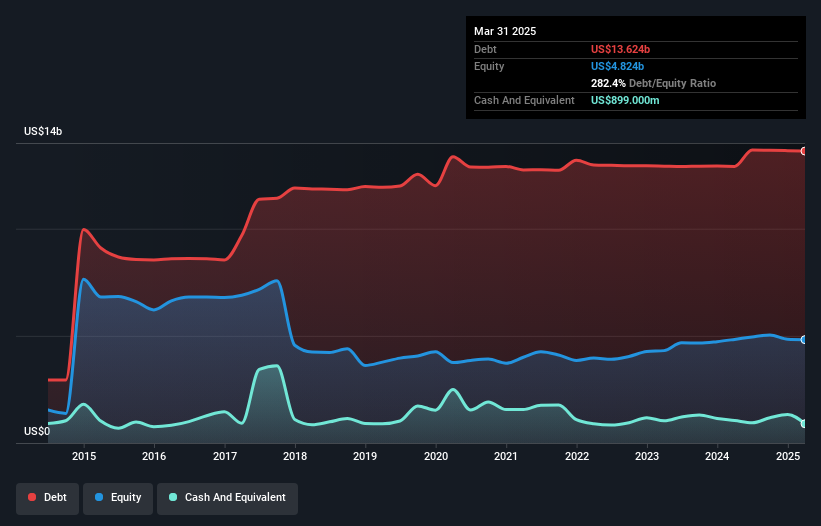- United States
- /
- Hospitality
- /
- NYSE:QSR
These 4 Measures Indicate That Restaurant Brands International (NYSE:QSR) Is Using Debt Extensively

Warren Buffett famously said, 'Volatility is far from synonymous with risk.' It's only natural to consider a company's balance sheet when you examine how risky it is, since debt is often involved when a business collapses. Importantly, Restaurant Brands International Inc. (NYSE:QSR) does carry debt. But is this debt a concern to shareholders?
Our free stock report includes 4 warning signs investors should be aware of before investing in Restaurant Brands International. Read for free now.When Is Debt Dangerous?
Debt assists a business until the business has trouble paying it off, either with new capital or with free cash flow. If things get really bad, the lenders can take control of the business. While that is not too common, we often do see indebted companies permanently diluting shareholders because lenders force them to raise capital at a distressed price. By replacing dilution, though, debt can be an extremely good tool for businesses that need capital to invest in growth at high rates of return. The first thing to do when considering how much debt a business uses is to look at its cash and debt together.
How Much Debt Does Restaurant Brands International Carry?
The image below, which you can click on for greater detail, shows that at March 2025 Restaurant Brands International had debt of US$13.6b, up from US$12.9b in one year. However, it also had US$899.0m in cash, and so its net debt is US$12.7b.

How Strong Is Restaurant Brands International's Balance Sheet?
Zooming in on the latest balance sheet data, we can see that Restaurant Brands International had liabilities of US$2.63b due within 12 months and liabilities of US$17.4b due beyond that. On the other hand, it had cash of US$899.0m and US$677.0m worth of receivables due within a year. So its liabilities total US$18.5b more than the combination of its cash and short-term receivables.
While this might seem like a lot, it is not so bad since Restaurant Brands International has a huge market capitalization of US$31.9b, and so it could probably strengthen its balance sheet by raising capital if it needed to. But it's clear that we should definitely closely examine whether it can manage its debt without dilution.
View our latest analysis for Restaurant Brands International
We measure a company's debt load relative to its earnings power by looking at its net debt divided by its earnings before interest, tax, depreciation, and amortization (EBITDA) and by calculating how easily its earnings before interest and tax (EBIT) cover its interest expense (interest cover). This way, we consider both the absolute quantum of the debt, as well as the interest rates paid on it.
Restaurant Brands International has a debt to EBITDA ratio of 4.9 and its EBIT covered its interest expense 4.1 times. Taken together this implies that, while we wouldn't want to see debt levels rise, we think it can handle its current leverage. Fortunately, Restaurant Brands International grew its EBIT by 6.3% in the last year, slowly shrinking its debt relative to earnings. The balance sheet is clearly the area to focus on when you are analysing debt. But ultimately the future profitability of the business will decide if Restaurant Brands International can strengthen its balance sheet over time. So if you want to see what the professionals think, you might find this free report on analyst profit forecasts to be interesting.
Finally, while the tax-man may adore accounting profits, lenders only accept cold hard cash. So we always check how much of that EBIT is translated into free cash flow. During the last three years, Restaurant Brands International produced sturdy free cash flow equating to 55% of its EBIT, about what we'd expect. This free cash flow puts the company in a good position to pay down debt, when appropriate.
Our View
Restaurant Brands International's struggle handle its debt, based on its EBITDA, had us second guessing its balance sheet strength, but the other data-points we considered were relatively redeeming. But on the bright side, its ability to to convert EBIT to free cash flow isn't too shabby at all. Looking at all the angles mentioned above, it does seem to us that Restaurant Brands International is a somewhat risky investment as a result of its debt. Not all risk is bad, as it can boost share price returns if it pays off, but this debt risk is worth keeping in mind. When analysing debt levels, the balance sheet is the obvious place to start. But ultimately, every company can contain risks that exist outside of the balance sheet. To that end, you should learn about the 4 warning signs we've spotted with Restaurant Brands International (including 1 which shouldn't be ignored) .
When all is said and done, sometimes its easier to focus on companies that don't even need debt. Readers can access a list of growth stocks with zero net debt 100% free, right now.
New: AI Stock Screener & Alerts
Our new AI Stock Screener scans the market every day to uncover opportunities.
• Dividend Powerhouses (3%+ Yield)
• Undervalued Small Caps with Insider Buying
• High growth Tech and AI Companies
Or build your own from over 50 metrics.
Have feedback on this article? Concerned about the content? Get in touch with us directly. Alternatively, email editorial-team (at) simplywallst.com.
This article by Simply Wall St is general in nature. We provide commentary based on historical data and analyst forecasts only using an unbiased methodology and our articles are not intended to be financial advice. It does not constitute a recommendation to buy or sell any stock, and does not take account of your objectives, or your financial situation. We aim to bring you long-term focused analysis driven by fundamental data. Note that our analysis may not factor in the latest price-sensitive company announcements or qualitative material. Simply Wall St has no position in any stocks mentioned.
About NYSE:QSR
Restaurant Brands International
Operates as a quick-service restaurant company in Canada, the United States, and internationally.
Average dividend payer slight.
Similar Companies
Market Insights
Community Narratives



